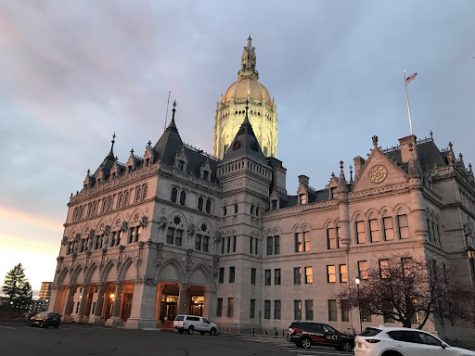Hybrid Mode and Its Pros and Cons
Hall High School Choraliers is a class at Hall that has been meeting virtually.
A famous person once said: “The capacity to learn is a gift; the ability to learn is a skill; the willingness to learn is a choice.” So what changed with the rise of COVID-19? Since the start of the global pandemic, schools have been fighting to maintain a balance between education and safety. While many schools across the country have yet to be reopened, Hall High School luckily has been able to return to a hybrid mode consisting of online learning and in-person learning.
Here’s what Hall’s Hybrid Mode looks like: the students have been divided into two cohorts, or groups. This division was alphabetical, so the first half of students are in the red cohort and the latter in the blue cohort. Each week of school, one cohort is learning in-person from 7:30am to 11:25am. The other remaining cohort ends up learning online from 12:00pm to 2:15pm. Every week, the cohorts switch; for example, I’m in the blue cohort, so if I was in school this week, next week I get to wake up at 11:30am in the morning and go to online school at 12. Now, of course, this raises an important question: are students still getting the quality education that they need? In my opinion, no, and here’s why.
Because our health is the first priority, we no doubt have to sacrifice some of our learning. For one, our capacity to learn is diminishing. Currently, we have alternating in-person and online learning, which is oftentimes dysfunctional. Teachers have resorted to variations of asynchronous work, where at the end of two weeks, both cohorts should’ve learned the same content. But this is incredibly hard to achieve due to our hybrid mode. Oftentimes, students in online learning don’t learn as much because the lessons are being done virtually, which makes it hard to ask questions and understand the content as well.
Further, perpetual internet problems make online learning infeasible. Speaking from experience, I’ve already missed almost 5 entire classes this year because the school internet crashed. This is an especially significant problem for some students whose internet may not be as stable and strong as other students. Additionally, in-person classes are not as smooth because students are often unsure of what work to complete and ultimately come to class empty-handed.
If this cycle continues, students will increasingly lag behind, culminating in an unreadiness for things like the AP exams. But even more, school days are so short now, and classes rarely meet often enough for students to get a concrete education. In the last month, I’ve had my AP Language & Composition class in-person about 4 times, whereas in a normal school year, I would’ve had that class in-person around 20 times.
This is not to say hybrid mode is “bad” or that we shouldn’t be using it. We all care about our safety and most people right now probably don’t want to risk getting sick just to get the best possible education. Hybrid mode is a good representation of what we can do in these times of struggle and symbolize hope for the future. While I may hold the opinion that we aren’t learning enough, we should continue to cherish our capability to learn, even though its limitations may devalue our education.



